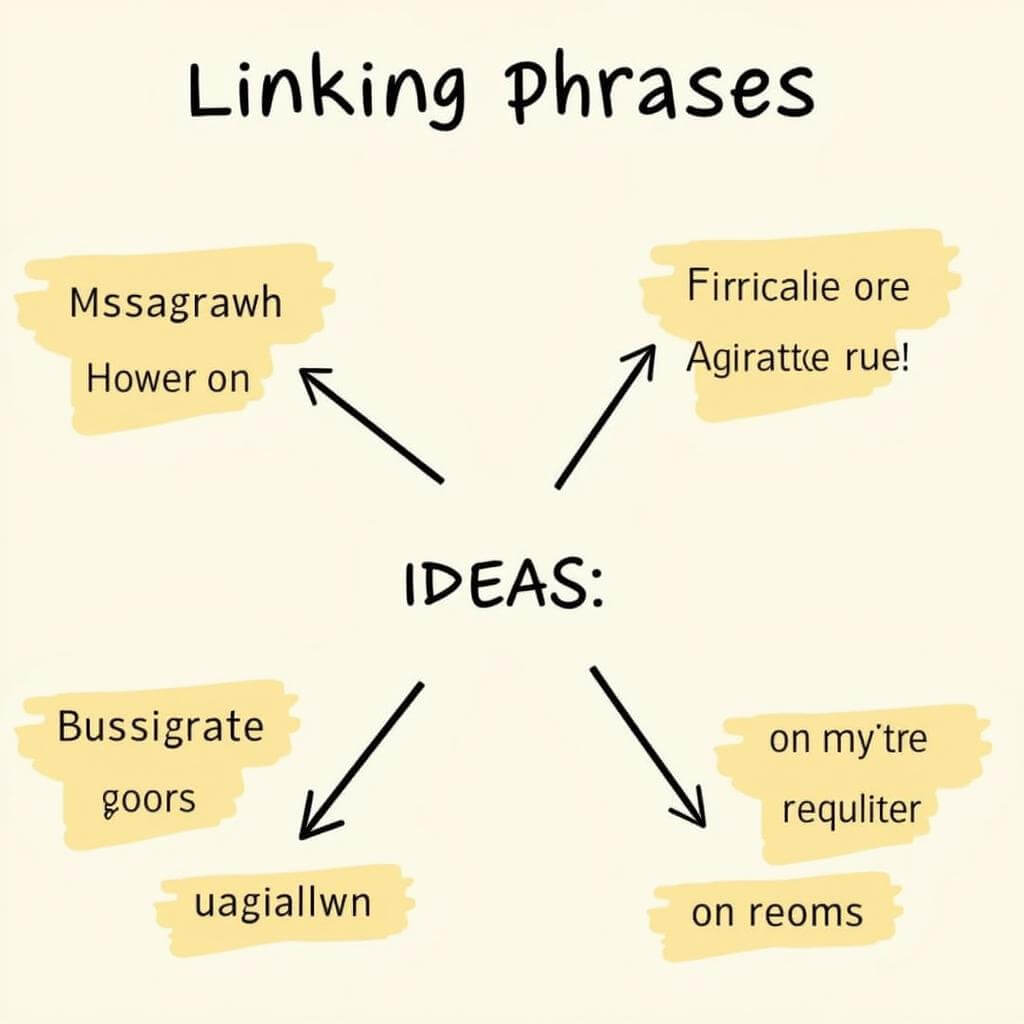IELTS Writing Task 2 can be challenging, but mastering the art of using linking phrases can significantly enhance your essay’s coherence and flow. This guide will explore effective strategies for incorporating linking phrases into your IELTS Writing Task 2 responses, helping you achieve a higher band score.
Understanding the Importance of Linking Phrases
Linking phrases, also known as cohesive devices, are crucial elements in academic writing. They help connect ideas, create smooth transitions between sentences and paragraphs, and improve the overall readability of your essay. In IELTS Writing Task 2, examiners specifically look for the appropriate use of these phrases as part of the Coherence and Cohesion criterion.

Types of Linking Phrases for IELTS Writing Task 2
Understanding the different types of linking phrases and their functions is essential for using cohesive devices in task 2. Here are some common categories:
-
Addition: To add information or ideas
- Furthermore
- Moreover
- In addition
- Additionally
-
Contrast: To show opposing ideas
- However
- On the other hand
- Nevertheless
- In contrast
-
Cause and Effect: To show relationships between ideas
- Therefore
- As a result
- Consequently
- Due to
-
Examples: To illustrate points
- For instance
- For example
- Such as
- To illustrate
-
Sequencing: To order ideas
- Firstly
- Secondly
- Finally
- Subsequently
Strategies for Using Linking Phrases Effectively
To maximize the impact of linking phrases in your IELTS Writing Task 2 essay, consider the following strategies:
1. Vary Your Phrase Selection
Avoid repetition by using a diverse range of linking phrases throughout your essay. This demonstrates a rich vocabulary and enhances the overall quality of your writing.
2. Use Linking Phrases Appropriately
Ensure that the linking phrases you choose accurately reflect the relationship between ideas. Misusing these phrases can lead to confusion and lower your coherence score.
3. Balance Usage
While linking phrases are important, overusing them can make your writing seem forced or unnatural. Aim for a balance, using them where they genuinely enhance the flow of your essay.
4. Practice with Context
Incorporate linking phrases into your practice essays to become more comfortable with their usage. This will help you use them more naturally in the actual test.
Common Mistakes to Avoid
When using linking phrases in IELTS Writing Task 2, be aware of these common pitfalls:
- Overuse: Stuffing your essay with unnecessary linking phrases can make it feel artificial.
- Incorrect usage: Using phrases in the wrong context can confuse the reader and affect coherence.
- Starting every sentence with a linking phrase: This can make your writing seem mechanical.
- Neglecting other aspects of cohesion: Remember that linking phrases are just one element of creating a cohesive essay.
Advanced Tips for Mastering Linking Phrases
To truly excel in using linking phrases, consider these advanced techniques:
1. Combine with Complex Sentences
Integrate linking phrases into complex sentence structures to showcase your grammar skills. For example:
“While some argue that technology has negative impacts on society, it is evident that, when used responsibly, it can lead to significant advancements in various fields.”
2. Use Linking Phrases for Paragraph Transitions
Employ linking phrases to create smooth transitions between paragraphs, enhancing the overall structure of your essay.
3. Adapt to Different Essay Types
Different IELTS Writing Task 2 questions may require different approaches. Adapt your use of linking phrases to suit opinion, discussion, or problem-solution essays.
practicing grammar through speaking tasks can also help you internalize these phrases for more natural writing.
Expert Insights
Dr. Emily Thompson, an IELTS examiner with 15 years of experience, shares her perspective:
“The most successful candidates use linking phrases judiciously. They understand that it’s not about quantity, but about quality and appropriateness. A well-placed linking phrase can significantly enhance the clarity and flow of an essay.”
Conclusion
Mastering the use of linking phrases in IELTS Writing Task 2 is a powerful tool for improving your essay’s coherence and potentially boosting your band score. By understanding the types of linking phrases, implementing effective strategies, and avoiding common mistakes, you can enhance your writing skills significantly. Remember, practice is key to perfecting this skill, so incorporate these techniques into your IELTS preparation routine.
As you continue to refine your writing skills, consider using synonyms effectively in writing to further enhance your vocabulary and expression in IELTS tasks.
FAQ
How many linking phrases should I use in my IELTS Writing Task 2 essay?
There’s no set number, but aim for a natural flow. Generally, 1-2 linking phrases per paragraph is sufficient, focusing on quality over quantity.
Can using too many linking phrases lower my IELTS score?
Yes, overusing linking phrases can make your writing seem unnatural and potentially lower your coherence score. Use them judiciously to enhance, not overwhelm, your essay.
Are there any linking phrases I should avoid in formal IELTS writing?
While not strictly forbidden, informal linking phrases like “what’s more” or “on top of that” are best avoided in favor of more academic alternatives.
How can I practice using linking phrases effectively?
Regular essay writing practice, focusing on incorporating a variety of linking phrases, is key. Also, reading academic articles can help you see how these phrases are used in context.
Do I need to use complex linking phrases to get a high score?
Not necessarily. Using simpler linking phrases correctly and appropriately is more important than using complex ones incorrectly. Focus on clarity and coherence.
Can linking phrases help in other parts of the IELTS test?
Absolutely! Improving sentence clarity with grammar, including the use of linking phrases, can benefit your performance in the Speaking and Reading sections as well.